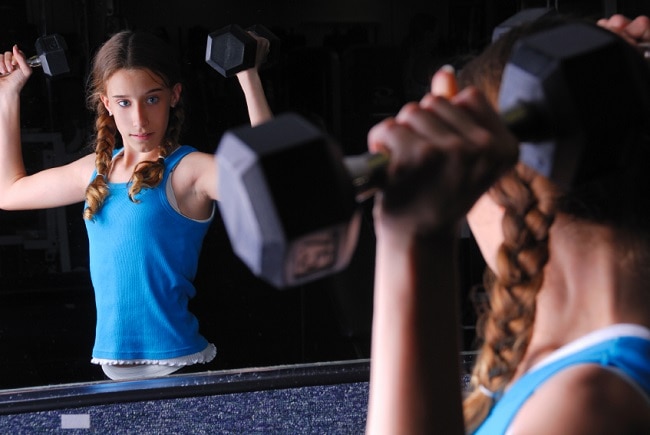Try to recall the first time you stepped into a weight room. Were you eight years old or 18? Did you have anyone to show you the ropes, or were you left to figure it out and “play” on your own? The answers to these questions can be the difference between creating long-term damage and leading a long, physically fit life. So before enrolling your kids in a regular strength-training program, think about the course you want them to follow. Age, skeletal maturity and access to professional guidance are all factors that should be considered.

There should be no argument that kids need to exercise more. When one in three American children are overweight or obese, it’s a national crisis. But there’s valid concern that over-exerting at a young age can do more harm than good. The Centers for Disease Control and Prevention recommends that children get at least 60 minutes of moderate to vigorous activity every day (hence the NFL’s Play 60 program). Now the question is what kind of activity do you encourage? Not all kids want to play sports, but is guiding your little one to the weight room a good alternative? Strength training may seem too intense for developing bodies, but there’s a strong argument to make it part of your child’s regular routine.
Why should strength training be considered?
Lifting weights can be a very effective form of cross-training for any sport, which is why it’s widely encouraged by coaches and trainers at all levels of the game. Not only can a strength-focused routine help build muscle mass and fascia flexibility for better sport-specific performance, a review from the National Institutes of Health (NIH) notes that it can help improve balance, bone density and lipid (aka fat) composition. That doesn’t even include the emotional benefits children can gain, including greater self-esteem and a sense of accomplishment, which are especially important for kids who are not sports-oriented.
What are the requirements?
According to the NIH review, “There is no minimal age requirement for participation [in weight training], although children must be able to follow directions and demonstrate adequate balance and proprioception, which generally occurs by 7 or 8 years of age.” Before starting any new exercise regimen, your child should see a medical professional for an annual physical exam. They’ll need to be cleared of any serious health conditions that could be worsened by strength training.
How do you get your kids started?
Like any physical activity, the right amount at the right intensity is the key to effectively integrating strength training into your child’s healthy lifestyle. Once the doctor gives a thumbs up, hire a certified personal trainer or experienced coach who can provide an educated introduction and well-organized program. Goals need to be discussed and set in place, but progress should never feel rushed. According to a 2002 study of strength training in children, kids can see significant gains in eight weeks when they’re consistently training twice weekly. As a parent, you’ll want a clear idea of what the trainer or coach should be teaching your child during each session. These are the most important components.
Adequate equipment: Walk into your local gym and there will be rows upon rows of weight machines, some very simple and others that look more like mousetraps. These are designed for the average adult. Chances are, your 10-year-old is not 5’ 9”…yet. That means finding a fitness center with child-sized equipment (if possible) or simply knowing how to adjust the adult machines to fit their smaller frame.
In addition to machines, your child may work with ropes, sandbags, resistance bands, medicine balls and dumbbells. There are pros and cons to each of these fun accessories. Typically, a trainer will start your newbie on a machine or doing bodyweight exercises, and then work them up to free weights once balance and coordination have been established.
Proper form: Even on machines, your child needs to focus on form. There is a wrong and right way to use each and every machine in the gym. Same goes for the simplest of exercises, like the dumbbell curl (elbows stable and close to the body). Proper form not only helps keep your child injury-free, but it’s the reason gains are made quickly. Knowing how to isolate muscles during a contracting or eccentric movement is essential to getting desired results.
Appropriate weight: Your adolescent should not be concerned with their one-rep maximum (1RM), as this style of training can be too much, too soon. That being said, weight load should start at a moderate level, defined by your child’s ability to perform 2 sets of 10 – 15 repetitions without muscle failure but with proper form (NIH).
Timely progression: Once a base resistance is determined for each exercise, your child’s trainer will begin increasing the load by about 10% every week, provided all other health factors are in place (normal sleeping patterns, a nutritious diet and a positive mindset). The deadline to the end goal (i.e. day of a race or sporting event) should be decided upon at the onset, so the trainer can plot out training progressions and help keep your child on track to meet – or exceed – their goal.
Where does it go from here?
Hopefully, it all goes up from here! If your child is comfortable and fit enough to start working out on their own, let them. Taking control of their health is a powerful tool that you want them to have. Keep introducing them to healthy foods and stimulant- and junk-free sports nutrition that will fuel their active bodies in the most natural way possible. With the foundation laid, all you have to do is sit back and watch them grow!
